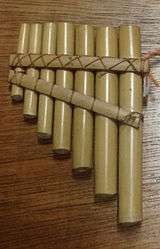Diwas
|
A Diwas of UP Center of Ethnomusicology | |
| Woodwind instrument | |
|---|---|
| Other names | Dad-ayu (Balangaw), Diwdiwas (Bontoc), Saggeypo (Kalinga), Dewdew-as (Tingguian) |
| Classification | Wind instrument |
| Hornbostel–Sachs classification |
412.112[1] (Sets of end-blown flutes or panpipes) |
| Related instruments | |
| |
 |
Diwas
Diwas sound sample. Each pipe in the Diwas was played. |
| Problems playing this file? See media help. | |
Diwas is a native bamboo wind instrument in the Philippines which is a variation of the well-known panflutes or panpipes. It is made of bamboo with one of its end closed via the node of the bamboo. It also does not have finger holes (or tone holes) which is unlike popular aerophones like flutes that have finger holes or tone holes to play different pitches on the instrument. But Diwas compensate on this by grouping pipes of graduated length together. So to produce sound with varying pitch, you shift from one pipe to another. In Kalinga, these individual pipes are known as Saggeypo which is why Diwas is sometimes called as Saggeypo. Usually, the number of Saggeypos strung together ranges from 5 to 8.[2]
Playing techniques
Simply, the instrument is played by blowing on the embouchure of the instrument. The embouchure has two distinct sides but both these sides can be used to play the instrument. However the big difference on these two sides, when you played on the side with shorter cutnstrument tend to produce higher pitch than when you played on the side with longer cut.
Science behind panpipes
How the instrument produce its sound can be traced by the concept of closed-end pipes/tubes. Basically, it is the very application of that concept. The starting point is at the time the person blows on the embouchure. As he blows, air jet enters the body of the instrument causing vibration inside the instrument. The slanted cut in the embouchure is responsible in controlling the air that will flow in the body. The time for this vibration to reach the end of the body and then get reflected back determines the frequency produced by the instrument. Thus the length of the tube is essential in determining the frequency produced by the instrument.[3]
Instrument variations
Most of the variations of the Philippine bamboo panpipes can be traced in Northern Luzon where the instrument is known by different names. In Balangaw, the instrument is called as Dad-ayu. In Bontoc, it is known as Diwdiw-as. In Tingguian, Dewdew-as. And in Kankanai it is still Diwas.[4] In these variations, the typical number of pipes consisted in the panpipes ranges from 5 to 8. The size, length and radius, of the instruments also varies from one ethnic group to another but there are no exact measurements for they do not depend highly on this. Also, the aesthetics of the instrument varies from one group to another.
Saggeypo
In Kalinga, Saggeypo and Diwas are the same because Saggeypo is the individual pipes in Diwas. There is no significant difference in the physical features of Saggeypo and Diwas. However, since Diwas is a group of Saggeypo strung together, the lengths of the pipe are more fixed. Typically, Saggeypo has no fixed length.
Physical features
The production of Diwas do not depend highly on exact measurements. This affects the generality of the music in indigenous tribes of the Philippines. Thus unlike the Western music which depends largely on musical notes in producing melody, indigenous music in the Philippines depends highly on rhythm. This is the very reason why sizes, length, radius, etc. of the instruments have no fixed value where these values are important in producing pitch.
See also
References
- ↑ List of aerophones by Hornbostel–Sachs number
- ↑ http://www.ncca.gov.ph/about-culture-and-arts/articles-on-c-n-a/article.php?i=155&igm=1
- ↑ http://www.sarahtulga.com/panpipes.htm
- ↑ C. Dioquinio. (2008) Philippine Bamboo Instruments. Humanities Diliman (January - December 2008), Vol. 5, No. 1 & 2, Pages 101-113. http://journals.upd.edu.ph/index.php/humanitiesdiliman/article/view/1484, accessed 04 September 2011.
